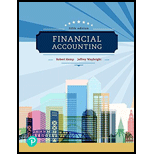
Financial Accounting
5th Edition
ISBN: 9780134728643
Author: Robert Kemp; Jeffrey Waybright
Publisher: Pearson Education (US)
expand_more
expand_more
format_list_bulleted
Question
Chapter 5, Problem 1CFSAP
1.
To determine
Describe how does the inventory of Company D is made up of, and also describe the inventory costing method that Company D uses.
2.
To determine
Compute the amount of inventory that has been invested on the
3.
To determine
Compute the amount of inventory that Company D have per store as of January 28, 2017 and January 30, 2016. Also describe whether the inventory per store is increasing or decreasing.
4.
To determine
Compute the amount of inventory turnover ratio for the year ending January 28, 2017.
5.
To determine
Compute the amount of Days-sales-in-inventory for the year ending January 28, 2017.
6.
To determine
Describe the performance of Company D on one’s point of view.
Expert Solution & Answer
Want to see the full answer?
Check out a sample textbook solution
Students have asked these similar questions
The standard materials cost to produce 1 unit of Product S is 5 pounds of material at a standard price of $35 per pound. In manufacturing 9,500 units, 46,800 pounds of material were used at a cost of $36 per pound. What is the total direct materials cost variance?
Define and differentiate between capital expenditure and revenue expenditure. Why is it important for businesses to classify these correctly in financial statements? Support your explanation with at least one example for each type of expenditure.
what would have been the amount of acual overhead ?
Chapter 5 Solutions
Financial Accounting
Ch. 5 - Prob. 1DQCh. 5 - How are the financial statements of a manufacturer...Ch. 5 - What is a cost-flow assumption? Why is a cost-flow...Ch. 5 - If a company had two units that cost 1 each in its...Ch. 5 - Prob. 5DQCh. 5 - Prob. 6DQCh. 5 - Prob. 7DQCh. 5 - Prob. 8DQCh. 5 - Prob. 9DQCh. 5 - Prob. 10DQ
Ch. 5 - During April, Bargain Hardware made sales of...Ch. 5 - Prob. 2SCCh. 5 - Prob. 3SCCh. 5 - Prob. 4SCCh. 5 - Prob. 5SCCh. 5 - Prob. 6SCCh. 5 - Prob. 7SCCh. 5 - Prob. 8SCCh. 5 - Prob. 9SCCh. 5 - Prob. 10SCCh. 5 - Prob. 11SCCh. 5 - Prob. 12SCCh. 5 - Prob. 1SECh. 5 - Prob. 2SECh. 5 - Prob. 3SECh. 5 - Prob. 4SECh. 5 - Prob. 5SECh. 5 - Prob. 6SECh. 5 - Prob. 7SECh. 5 - Prob. 8SECh. 5 - Lower-of-cost-or-market rule (Learning Objective...Ch. 5 - Prob. 10SECh. 5 - Inventory principles and terminology (Learning...Ch. 5 - Prob. 12SECh. 5 - Prob. 13SECh. 5 - Prob. 14SECh. 5 - Prob. 15SECh. 5 - Prob. 16AECh. 5 - Prob. 17AECh. 5 - Prob. 18AECh. 5 - Prob. 19AECh. 5 - Prob. 20AECh. 5 - Prob. 21AECh. 5 - Prob. 22AECh. 5 - Prob. 23AECh. 5 - Prob. 24AECh. 5 - Prob. 25AECh. 5 - Prob. 26AECh. 5 - Prob. 27AECh. 5 - FIFO (Learning Objective 2) 10-15 min. Tee Time,...Ch. 5 - LIFO (Learning Objective 2) 10-15 min. Refer to...Ch. 5 - Prob. 30BECh. 5 - Prob. 31BECh. 5 - Prob. 32BECh. 5 - Prob. 33BECh. 5 - Prob. 34BECh. 5 - Prob. 35BECh. 5 - Prob. 36BECh. 5 - Prob. 37BECh. 5 - Prob. 38BECh. 5 - Prob. 39BECh. 5 - Computing LIFO and journalizing inventory...Ch. 5 - Prob. 41APCh. 5 - FIFO, LIFO, and average cost (Learning Objectives...Ch. 5 - Prob. 43APCh. 5 - Prob. 44APCh. 5 - Prob. 45APCh. 5 - Estimating ending inventory (Learning Objective 7)...Ch. 5 - Prob. 47APCh. 5 - Prob. 48BPCh. 5 - Prob. 49BPCh. 5 - FIFO, LIFO, and average cost (Learning Objectives...Ch. 5 - Prob. 51BPCh. 5 - Prob. 52BPCh. 5 - Prob. 53BPCh. 5 - Prob. 54BPCh. 5 - Prob. 55BPCh. 5 - Continuing Exercise This exercise continues the...Ch. 5 - Prob. 1CPCh. 5 - Prob. 1CFSAPCh. 5 - Prob. 1EIACh. 5 - Prob. 2EIACh. 5 - Prob. 1FACh. 5 - Prob. 1IACh. 5 - Prob. 1SBACh. 5 - Prob. 1WCCh. 5 - Comprehensive Problem The Accounting Cycle for a...
Knowledge Booster
Similar questions
- I need assistance with this financial accounting question using appropriate principles.arrow_forwardSolve with explanation and accounting questionarrow_forwardWhen preparing the trial balance, the accountant of Zenith Co. noticed that the debit column exceeded the credit column by $1,000. Which of the following errors could cause such an imbalance? A) A transaction not recorded at all B) Reversing the debit and credit C) Posting an amount twice to the debit side D) Recording a sale as a purchase MCQarrow_forward
- What are the required sales?arrow_forwardLuma Corp. had net credit sales of $2,400,000 in 2023. The beginning accounts receivable balance was $180,000, and the ending balance was $210,000. (a) What is the receivables turnover? (b) What is the average collection period in days?arrow_forwardWhat is the desired profit for the year?arrow_forward
arrow_back_ios
SEE MORE QUESTIONS
arrow_forward_ios
Recommended textbooks for you
- Principles of Accounting Volume 1AccountingISBN:9781947172685Author:OpenStaxPublisher:OpenStax CollegeCentury 21 Accounting Multicolumn JournalAccountingISBN:9781337679503Author:GilbertsonPublisher:Cengage
- Principles of Accounting Volume 2AccountingISBN:9781947172609Author:OpenStaxPublisher:OpenStax College
 Financial Reporting, Financial Statement Analysis...FinanceISBN:9781285190907Author:James M. Wahlen, Stephen P. Baginski, Mark BradshawPublisher:Cengage Learning
Financial Reporting, Financial Statement Analysis...FinanceISBN:9781285190907Author:James M. Wahlen, Stephen P. Baginski, Mark BradshawPublisher:Cengage Learning

Principles of Accounting Volume 1
Accounting
ISBN:9781947172685
Author:OpenStax
Publisher:OpenStax College

Century 21 Accounting Multicolumn Journal
Accounting
ISBN:9781337679503
Author:Gilbertson
Publisher:Cengage



Principles of Accounting Volume 2
Accounting
ISBN:9781947172609
Author:OpenStax
Publisher:OpenStax College

Financial Reporting, Financial Statement Analysis...
Finance
ISBN:9781285190907
Author:James M. Wahlen, Stephen P. Baginski, Mark Bradshaw
Publisher:Cengage Learning